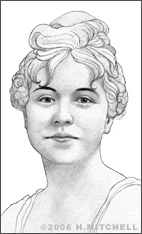Rose O'Neill
The artistic talents of illustrator, inventor, and suffragist Rose Cecil O’Neill sparked a worldwide craze at the start of the 20th century when she turned one of her best-loved hand-drawn characters into a three-dimensional toy. This toy is none other than the instantly recognizable Kewpie doll. The doll and merchandise bearing its likeness remain collectibles to this day.
Born in Wilkes-Barre, Pennsylvania on June 25, 1874, O’Neill was one of six children born to William and Asenath O’Neill, who moved the family to Battle Creek, Nebraska in 1876. Rose loved to draw as a child, and she got an early professional start when she entered and won an art contest sponsored by the Omaha World Herald at 14 years old. She was invited almost immediately to begin illustrating magazine and newspaper articles. Throughout her teenage years, she worked professionally, illustrating “Arabian Nights” for a magazine called The Great Divide, and she began illustrating a novel she wrote herself, “Callista,” which was the name of one of her siblings.
In 1893, she traveled to New York to see the World’s Fair, where she got her first glimpse of modern art. She thought she might be ready to embark on a career as a novelist, but others encouraged her to continue her education. So, she entered the Convent of the Sisters of St. Regis in New York City. For three years, she refined her drawing technique there and picked up a number of high-profile clients, including Harper’s Weekly, Bazaar, Truth, and Collier’s Weekly.
Meanwhile, her parents and siblings moved once again to a country home in the Ozarks region of Missouri. With her earnings, Rose was able to help build a larger home for the family, which became the O’Neills’ beloved Bonnie Brook homestead.
Rose O’Neill continued working in New York and building on her client base. Over the years, her drawings appeared in the most popular magazines of the era, including Good Housekeeping, Ladies Home Journal, Life, Puck, and many others. She married Gray Lathan in 1896 (whom she divorced in 1901) and began using the signature O’Neill Lathan on her works. At the time, the field was dominated by men, and this was somewhat of a help to her career. She also illustrated a variety of books, written by such authors as Parker Fillmore and Harry Leon Wilson, the literary editor of Puck, to whom she was married from 1902 to 1908.
According to O’Neill, the cherubic-looking characters upon which the Kewpie doll was based came to her in a dream. She began to include these chubby, child-like “elves” in the backgrounds of many of her drawings. When the Ladies Home Journal editor asked her to make a series of illustrations of just these creatures alone, she did so for the publication, which planned to write verses to accompany them so they would have their very own story. Thus the “Kewpies,” which performed good deeds for regular people, took on a life of their own.
The characters and their stories appeared in Woman’s Home Companion and Good Housekeeping, as well as in cartoons and books and later as paper dolls. They became an instant hit among children and adults alike. O’Neill’s book “The Kewpies, Their Book” was released in 1910.
Inevitably, children soon expressed their desires to have an actual Kewpie to hold and play with. O’Neill moved to Europe from 1911 to 1914, and while attending art school in Paris, she began working on plans to mold the Kewpie into a doll. This was a challenge for her with her limited experience in sculpture, but with the help of fellow students and others, she managed to create a statuette that served as a mold. A German factory agreed to manufacture the dolls out of bisque. The dolls hit the international marketplace with incredible success in 1912. O’Neill obtained a patent for the doll in 1913.
The Kewpies were later manufactured in Belgium, France, and the United States after the outbreak of World War II. Meanwhile, merchandising for the dolls exploded, and O’Neill published additional Kewpie books while others created Kewpie dishes, calendars, and other household items. O’Neill is said to have earned at least $1.5 million from the Kewpie franchise, which is equivalent to at least $15 million today. O’Neill lived lavishly with her fortune, purchasing homes in Connecticut, the Isle of Capris, and Greenwich Village, New York. She also continued to illustrate and write novels. Her first novel, “The Loves of Edwy” was published in 1904 when she was just 19 years old. She wrote “Lady in the White Vail” in 1909, a book of poetry, “Master Mistress,” in 1922, “Garda” in 1929, and “The Goblin Woman” in 1930.
She also continued to visit Europe regularly and held her own artwork exhibition in Paris in 1921 at the Galerie Devambez. Stateside, she began to hold salons at her Greenwich Village apartment and became a vocal supporter of women’s right to vote. In addition, she created other characters that became toys, including the Scootles doll in 1925 and the Ho Ho doll in 1940.
She returned to Bonnie Brook in 1937 and lived out the remainder of her years there. O’Neill died on April 6, 1944, shortly after completing her memoirs.


